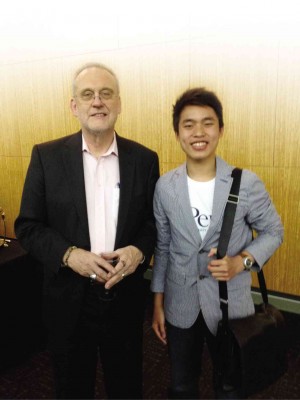
“What I think people should learn from Silicon Valley is a great sense of openness, optimism, possibility, a willingness to learn by doing and experimenting. Don’t be afraid to fail—that’s a really important lesson from Silicon Valley.”—John Temple, former managing editor of the Washington Post
Each year, around 20 journalists are chosen as John S. Knight Fellows; they take on the challenge to push boundaries and create products that will help improve the quality of information reaching the public.
Opportunities
By taking advantage of the different classes and opportunities in Stanford University and Silicon Valley, the Knight fellows are able to explore a variety of fields and be exposed to new ways of practicing journalism.
When I found out that these fellows would be presenting their yearlong projects in an event called “Reengineering Journalism,” I knew I had to be there.
In the past few years, technology has changed the way people get information. Many read the news from websites and social networks uploaded on their smartphones. As a result, journalism continues to evolve.
Knight fellow Cindy Royal is trying to help journalists keep up with the evolution; a firm believer in the intersection of media and technology, she has created “codeactually.com,” a website that will teach essential programming skills that journalists need to stay on top of their game.
Interactive cartoons
Gus D’Angelo, on the other hand, wants to take us back to the days when he looked forward to reading the Sunday comics. Believing that news should also excite and inspire, he plans to unleash the potential of digital comics by creating an open-source platform for interactive cartoons and comics for both smartphones and tablets.
Trying to solve problems they’ve encountered in their respective countries, Kennedy Jawoko and Qian Kejin developed DragonLion (www.dragonlion.com), which facilitates connection between China and Africa, while also implementing an action-oriented training program for journalists in both countries. DragonLion allows them to collect large data from both countries, while also creating a network of journalists in Africa and China.
‘Talk to them’
Vietnamese journalist and former RedEye general manager Tran Ha left the audience thinking as she challenged everyone to ask a different question in coming up with their articles. For the youth generation called millennials, it has become even more important to understand their needs because they are the future of news. In her simple words, she advises us to “talk to them.”
Ana Carrano, meanwhile, is trying to solve a problem that most journalists can surely relate to—transcribing interviews. Her project, Voyzes (www.voyz.es) provides ways to store your audio and reliably transcribe them into text.
She hopes that Voyzes will become a database for raw interviews, and a tool to automatically transcribe these interviews.
Story timeline
I was able to interview former ESPN editor Eric Ortiz, who is working on his media application startup Evrybit (https://getevrybit.com). Evrybit is a mobile-first publishing tool for video, photos and text, in the process creating a story timeline that multiple users can contribute to. With Evrybit, anyone can become a journalist or a storyteller, and when that happens, you get every bit of the story!
Former Washington Post managing editor John Temple also sat down for an interview with Knight Fellowship director Jim Bettinger, who asked him: “What should journalists do to
have an impact in journalism in the 21st century?”
Hard work
Temple’s reply: “First of all, you will want to have that impact. Journalism is not an easy field; it’s not the glamor of being in front of the TV camera or being up on stage. It’s really hard work and I wish the public understands that good journalism is really hard work.
“I think the most important thing (in making an impact) is engaging with others who have the same sense of passion, commitment and drive… and then learning from each other because something special happens when you get in the right group of people… You can see this in the Knight Fellowship and the way this group has developed.”
I left the fellowship optimistic about the future of journalism. With the evolution of technology, it’s now about becoming, in the words of Ortiz, “journapreneurs”—finding innovative ways to engage, inform, excite and, ultimately, bring people together through the stories we tell.
Visit www.knight.stanford.edu.